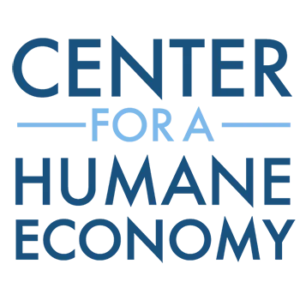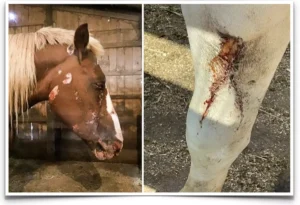Press Release



- For Immediate Release:
- Contact
- Wayne Pacelle, president
- Animal Wellness Action, Center for a Humane Economy
- 202-420-0446
- Email Wayne here
- Contact
- Sonja Meadows, president and founder
- Animals’ Angels
- 240-350-1758
- Email Sonja here
Landmark Field Investigation of Horse Slaughter in North America
Cruelty to “Kill” Horses Is Rampant and Unrelenting Even As the Scale of Slaughter Retreats With Plummeting Demand in the Old World
Washington, D.C. – A joint investigation and analysis released today and conducted by the Center for a Humane Economy, Animal Wellness Action, and Animals’ Angels reveals that the extraterritorial slaughter of American horses is rapidly waning, but it’s still a merciless journey for around 20,000 American horses.
The report may be accessed here.
The report shows that horses used in racing, show rings, work for police or on farms, and even as companions are opportunistically obtained by “kill buyers,” kept in bare-minimum survival conditions at holding facilities and transported as standing cargo in trucks jam-packed with frightened and desperate animals. Then, with their eyes wide as saucers, the horses are butchered at slaughter plants in Canada and Mexico. With no markets for horse meat in North America, the slabs of meat are destined for small and shrinking pockets of foreign markets in China, Italy, Japan, Russia, and a few other nations. The number of American horses destined for slaughterhouses has gone from 350,000 in 1990 to 140,000 in 2007 to 20,000 in 2022.
“The good news is that foreign demand has cratered for the North American horse slaughter industry and horse slaughter has been in free fall,” said Wayne Pacelle, president of the Center for a Humane Economy.
“Yet our investigation finds that there can be no worse option for a horse than to be obtained by a ruthless set of commercially linked actors who disreputably obtain horses and then terrorize, injure, and butcher them for meat that nobody needs and very few want.”

The report finds that the instant a horse is designated a “kill horse,” handling and treatment deteriorate from horses previously treated as companions or working animals. The kill horses have limited value while alive, and inputs in the form of feeding, watering, and care only diminish.
“If the ‘kill horses’ were under the care of a different type of owner, humane officers and police would require, in keeping with state animal cruelty laws, proper veterinary care and sufficient access to food, water and shelter,” said Scott Beckstead, campaigns director for the Center for a Humane Economy and a national instructor on horse cruelty investigations. “But these horse collectors and dealers operate outside the law with near impunity.”
SOME KEY REPORT FINDINGS
The report summarizes independent findings from investigations carried out at auctions, feedlots, and slaughter plants. All locations selected for this report were chosen based on 15 years of investigating the horse slaughter industry. They range from the Presidio Export Pens on the border with Mexico to the Bar S Feedlot in Montana near the border with Canada; from the New Holland Auction in southeast Penn. to the Knoxville Auction in Tenn.; and from Fabrizius Livestock in Eaton, Colo. to the Murphy’s Horse Auction in Mira Loma, Calif. The horses’ journey concludes at a number of horse slaughter plants in Mexico, and at the last two remaining plants in Canada — Bouvry Exports, Ltd. in Alberta and Viande Richelieu in Massueville, Quebec.
“The results of the recent investigations confirm what Animals’ Angels has documented again and again over the 15 years: Horse slaughter is a predatory business that allows a select few to profit on the backs of our horses while ignoring animal protection laws and jeopardizing public health and safety,” said Sonja Meadows, president and founder of Animals’ Angels.
Because of potentially lethal drug residues in horse meat, given their backgrounds as companions, working animals, racehorses, and pleasure horses, the European Union banned the import of all horse meat from Mexico (amending Decision 2011/163/EU) in December 2014. In October 2016, EU Regulation 2016/1832 was implemented, which includes a provision requiring that all horses from the United States be kept in a Canadian feedlot for six months prior to slaughter, and that a monitoring system be put into place to track residues and substances referred to in Annex I to Directive 96/23/EC.
Combined with greater awareness of food safety problems and animal cruelty concerns, foreign demand has decreased, especially in Europe.
“Our investigation clinches the case for Congressional action to ban the live export of horses for slaughter for human consumption,” said Marty Irby, executive director Animal Wellness Action and an 8-time world champion equestrian. “There are anti-horse slaughter super-majorities in the House and Senate already, and with the findings in this report, those numbers will only swell.”
Killing and butchering horses for human consumption was halted in the United States in 2007 through a series of legislative and judicial actions and has not resumed, but no similar national rules apply in Canada or Mexico. There is no trade group that represents the North American horse slaughter industry, according to our report, and that means there are no voluntary standards of care or transportation protocols outside of the slaughterhouse operations.
Some sample findings in the 34-page report include:
- The horse slaughter infrastructure is rickety and fraying. We found that the largest holding facility for “kill” horses in North America — a feedlot in Shelby, Montana with capacity to upwards of 1,800 horses in pens — cut ties with Montana’s livestock agency last fall and shut its doors to holding American horses on their way to slaughter.
- During previous visits to the Presidio export facilities in Texas, at least five U.S. trucks per day were observed delivering horses, and between four and six loads of horses were exported to Mexico. During the January 2023 three-day investigation, only one U.S. truck was observed delivering horses and not a single Mexican truck arrived to export horses to Mexico. The roof of the Alvarado holding operation had caved in, and the entire property was covered in trash. The Baeza pens also appeared dilapidated and were empty. The impact of the EU ban of Mexican horse meat and the general decrease in demand for the meat were evident.
- On Dec. 6, 2022, investigators followed a slaughter horse transport that was leaving the Chavez feedlot in New Mexico. When the truck, which was heading to the Mexican border, stopped to fuel, investigators noticed that a horse in the back compartment was being trampled by the other horses. They alerted the driver, who was able to get the horse back up by poking it with a stick. However, the horse appeared very weak and unstable, and the truck should have returned to the feedlot but continued on to Mexico. Animals’ Angels has reported the incident to USDA Investigative Enforcement Services and an official investigation was launched. The case is ongoing.
- Bouvry Exports Ltd., the largest remaining horse slaughter plant in Canada, is surrounded by several company-owned feedlots that provide a steady supply of horses to the plant. Horses acquired in the United States are kept inside the feedlots for six months before being slaughtered to comply with EU drug residue requirements. The slaughter plant holding pens have no protection from the harsh environment and no access to shelter. Past investigations have shown dead foals, frozen to the ground, inside the pen. The skeletal remains of two other horses were found just outside the pen area. Injured and sick horses and horses with severely overgrown hooves were also documented.
In broad terms, there is no enforcement structure to ensure compliance with state anti-cruelty laws and federal transport regulations, with the intermediate players in the industry having no rules for themselves and little to no government oversight. Mistreatment of horses throughout the slaughter pipeline is well documented in the report (photos, cases, and reports) and includes dragging downed horses from trailers, allowing foals to freeze to death outside, and withholding help and relief from horses with significant injuries.
Contagious diseases, such as Strangles, fester at slaughter holding facilities and are incubators for contagious diseases. At export, there are limited disease surveillance issues, but nothing robust or designed to protect the horses from mistreatment.
“This is a loose network of kill buyers, transporters, holding facility operators, and foreign slaughterhouses,” said Manda Kalimian of the CANA Foundation, a partner with the Center for a Humane Economy. “This band of modern-day horse robbers has no heart and or soul.”
HORSE SLAUGHTER IS CRUELTY, NOT HORSE CONTROL
The industry is driven not by any sort of concern for “a surplus” of American equines or a caring or even practical instinct to find a population equilibrium for our domestic population, but by opportunistic collection of horses in the United States and by a diminishing foreign demand. If present trends continue, the slaughtering of American horses in foreign slaughter plants may head toward nil within five to 10 years.
Even at current levels, there can be no logical argument that horse slaughter serves as any kind of major safety valve on the disposition of unwanted, elderly, or ill horses. There are more than 500,000 horses dying every year in the United States, and horse slaughter provides an end-of-life outcome for only three percent of them. Based on our investigation, we can hardly imagine a worse fate for horses than to be funneled into a ruthless, uncaring slaughter pipeline.
The report notes that Mexican slaughter plants killed 16,362 American horses in 2022 and Canada has killed 2,829 (through Sept. 30, 2023).
“To suggest that the horse slaughter industry is, in any way, providing an important safety valve in controlling captive horse populations is akin to claiming that random acts of violence by street gangs are contributing to human population control,” added Pacelle. “The killing, at present levels, has a negligible continent-wide effect on population size, and its practices are as coarse and cold-blooded as they come.”
The field work for the investigation lasted six months and wrapped up in late January. In the 117th Congress Reps, Jan Schakowsky, D-Ill., and Vern Buchanan, R-Fla, and Senators Robert Menendez, D-N.J., and Lindsey Graham, R-S.C., introduced legislation to codify a horse slaughter ban in the U.S. and to ban live exports of horses to Canada and Mexico for slaughter.
Animal Wellness Action (Action) is a Washington, D.C.-based 501(c)(4) organization with a mission of helping animals by promoting legal standards forbidding cruelty. We champion causes that alleviate the suffering of companion animals, farm animals, and wildlife. We advocate for policies to stop dogfighting and cockfighting and other forms of malicious cruelty and to confront factory farming and other systemic forms of animal exploitation. To prevent cruelty, we promote enacting good public policies and we work to enforce those policies. To enact good laws, we must elect good lawmakers, and that’s why we remind voters which candidates care about our issues and which ones don’t. We believe helping animals helps us all.
The Center for a Humane Economy (“the Center”) is a non-profit organization that focuses on influencing the conduct of corporations to forge a humane economic order. The first organization of its kind in the animal protection movement, the Center encourages businesses to honor their social responsibilities in a culture where consumers, investors, and other key stakeholders abhor cruelty and the degradation of the environment and embrace innovation as a means of eliminating both.
Animals’ Angels is a non-profit organization that carries out undercover investigations in the United States, Canada and Mexico to document the way animals are treated at auctions, feedlots and slaughter plants. Its focus is on raising awareness about the cruelty animals in commercial operations face every single day and on holding those responsible accountable for their actions.